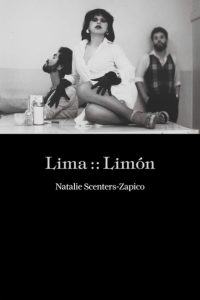by DEBORAH BACHARACH

Natalie Scenters-Zapico, Lima :: Limón (Copper Canyon Press, 2019), pp. 75
This review originally appeared in the Fall 2019 print issue of Carolina Quarterly.
Burns, screams, blood—violence against women happens quick and ferocious in Natalie Scenters-Zapico’s second book of poetry Lima :: Limón. These poems live in a world where women are attacked, belittled, and controlled not just by individual men or dangerous cartels, but by an entire society set up to tell them marriage and obedience to men are their only option. As Scenters-Zapico tells us, “where / I’m from it’s a blessing not to be / a woman gagged by electrical tape / & bound to the hood of car.” Lima :: Limón’s joyful defiance comes when these same women dance on the table or take pen in hand. As Scenters-Zapico says, “In the age of Los Zetas, I am a lucky hembra :: I have the language to write of the violence of machos.” As these poems traverse the Mexico-U.S. border, we see the speaker’s body at the physical border as she reenacts an illegal crossing, on the linguistic border as so many of the poems have rivulets of Spanish in them, and on the political border as Scenters-Zapico takes on Trump’s rhetoric about the wall.
In three sections introduced by song lyrics popular in her communities, Scenters-Zapico shows this borderland violence as it focuses on girls, women, and mothers. Juxtaposing the song lyric epigrams with words from those lyrics in her poems, Scenters-Zapico critiques the culture. The first epigram has the refrain “from the lemon to the lime” where girls taunt each other that you will have no one to love you and you will end up single. Scenters-Zapico’s first poem, “Lima Limón :: Infacia,” speaks back to that lyric, letting the young woman demand to be the desired one and sensual, but not just as a symbol but in all the parts as a real lemon—the rind, the pith. However, a woman choosing to be sensual is dangerously transgressive in a culture with a strong Madonna/whore dichotomy. In “Lima Limón :: Azahar” the speaker lets us know:
“He says my moisture
brings mold & my body is nauseating.
I wonder if I had not said his name over & over
would he still think of me as small & round
& fresh as lemon—as vaginal & arched as limón.”
Many of Scenters-Zapico’s poems take on this either/or identity thrust on women. Her very use of punctuation draws attention to dichotomies whether it be between a lima and a limón, between male and female. I read the double colon between the words in her titles as the signal of an analogy—‘this’ is to ‘that.’ She often juxtaposes a title’s analogy, a theoretical construct, with vivid concrete action in the poems, both grounding the concept and widening its implications. So, when we read “With one hand / across my mouth, an arm across my shoulders & the weight of his body / he repeatedly beat my head against brick until a faucet of blood opened / from my head down my back,” the title “Macho :: Hembra” lets us know this is not just about these two people, but is instead a larger indictment of the relationship between men and women. In section two, there are six poems with the title “Macho :: Hembra,” each one adding to the analogy. Scenters-Zapico does not just use the “::” punctuation once or twice, but revisits it continuously. This mark “::” signals and visually represents relationship across dichotomies, a central theme in the book.
In relationship but not usually in good relationship. And Scenters-Zapico will not let that violence stand. Another central theme, anger. Sometimes the anger comes through with sarcasm. In “Neomachismo,” she writes, “Anger is the emotion of men. By adding sugar, lime & salt you can turn / anger into sadness as a good woman should.” Using language to signify its opposite in order to convey contempt? Check.
In “More Than One Man Has Reached Up My Skirt,” a title that already signals resistance because she is naming what she is supposed to accept, she writes:
“My mother used to cover
my eyes
when we’d walk by girls
working the corner
& say:
See how lucky you are,
not to have to work
like they do? I have been
muy puta,
have been called puta.
Yes, I’d say, very lucky.”
I can just hear that “lucky” at the end said with a sneer and an eye roll. But more often, the anger gets its power from understatement. In the first poem titled “Macho: Hembra” she uses plain spoken sentences and a very matter of fact tone to speak of a lover calling her “tonita” (dumb) the way her father called her mother and ends with “A good hembra never speaks of the violence of men.” The anger comes through in the contrast between the clarity of the statement and the horror of which it speaks. The speaker in these poems is clearly not a good “hembra” because she does speak over and over again about the violence of men. She doesn’t have to rant; to just speak confronts the culture.

Scenters-Zapico uses three different kinds of language to take on horror: lyric, clinical, and surreal. In “My Macho Takes Good Care of Me,” the speaker is a native Mexican woman now married to a United States citizen. She tells us her husband “wants mas, mas, / y mas in his united estates. I give him all of me served on a platter from back home: plump, cracked & ready-made.” The figurative language—the woman has become the meal—obliquely comments on the struggles in this relationship.
“His thumb, index &
middle fingers from his right hand, the same hand he used to muffle my
screams, were found in the glove compartment. Mutilation turns you
into a body unbeckoned.”
“Thumb, index, & middle fingers” are very clear, almost clinical language, but hidden inside this prose poem, set up like a newspaper paragraph, is the line “screams, were found in the glove compartment. Mutilation turns you” which puts the screams in the glove box, a terrifying and evocative image and couples that with the powerful tone of a wisdom statement “mutilation turns you.” Scenters-Zapico won’t give up her poetic power to horror.
Using surrealism, she allows women to fight back against humiliations and attacks by turning themselves into a bowl of ice cream. The speaker mines her body for rubies that she can control, and Scenters-Zapico brings in surrealism to talk about emotions, like how it feels not being able to carry a child to term, that might be too strong for ordinary words. She writes in “You are a Dark Body”:
“As a woman you receive sores from him & through
the sores you breathe & despite the sores you give birth
to a child stillborn for lack of water.”
Her surrealism creates a complicated creation myth that communicates more to the gut than the brain.
Before I leave you with this striking book, I want to talk about the elefante in the room—Spanish, which shows up in almost every poem: in what a lover says, in what the speaker says back, in slurs on the street, in prayer. Incorporating Spanish without translating or providing an English appositive is an integral part of Scenters-Zapico’s aesthetic.
I do not speak a lick of Spanish. I didn’t know Los Zetas was a Mexican criminal organization running a drug cartel or azahar meant orange blossom. But, it didn’t take me that long to look up translations, and anyway, poetry should be read slowly. Yes, I missed sound effects, connotations, a cultural context. It’s fair to say that someone fluent in English and Spanish will get more from this book than someone like me. By the same token, someone who has lived in El Paso, Texas or Ciudad Juarez, or Chihuahua will also find resonances those of us who haven’t will miss, but that doesn’t mean we should miss this poetry. We all live in this world of violence and dichotomies. These poems help us see clearly and feel intensely.

